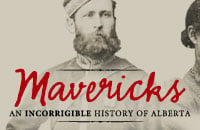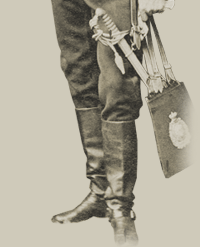

 |
|
GlossaryGlossaries have been created to provide the definition for words specific to each theme area. It is suggested that students review the glossaries before they examine a specific theme area. For example, the Ranching Glossary contains many terms such as "greenhorn," "heifer," or "wrangler," that only a rancher or cowboy might know. Bedroll: A cowboy's sleeping blankets rolled up for easy carrying on his horse. Big Four: The first Calgary Stampede was held in September of 1912. A man named Guy Weadick wanted to celebrate Alberta's ranching lifestyle and traditions, but needed money for the event. Four ranchers guaranteed him $25,000 each (a great deal of money of money at the time) for what was supposed to be a one time event. These four ranchers, George Lane, Alfred Earnest Cross, Pat Burns and Archie McLean are now known as the "Big Four." Bit: The metal mouthpiece on a bridle that is connected to reins. Together they are used to steer the horse. Bovine: An animal of the genus Bos, such as an ox, cow, or buffalo. Branding: The practice of searing a cow's flesh with a red-hot iron to produce a scar that will be easily recognizable to allow cowboys to identify ownership. Now branding is often done with chemicals, tattooing, freezing, or ear-tagging. The Ancient Egyptians and Greeks were the first to use branding. Branding Iron: An iron tool used to brand a cow for identification of ownership. Broken Horse: A horse that will allow you to ride it. Bronc: Bucking horses that are ridden wearing a saddle. Bronc busting (or breaking): training an animal to accept being ridden. Bronco: An animal that has not been broken to accept being ridden. In Spanish it means "rough" or "harsh." Bull: A male bovine used to father cattle in a herd of cows. Calf: The young animal from domestic cattle. A baby cow. Cattle: Any domesticated animal of the genus Bos, including cows, steers, and bulls, often raised for their meat and dairy products. Cattle Rustling (Rustler): A cattle thief. A camp cook might also be called a rustler, as they has to "rustle" up some grub (food) for the cowboys. Cavvy: A ranch's saddle horses used on a roundup. The cavvy of horses were gathered in a rope corral, which was usually temporary, allowing the cowboys to change horses when needed. Chaps: Pronounced "shaps," these are leggings worn by cowboys as protection against the weather and brush, and are usually made of leather. Chuck: Cowboy slang for a meal. Similar to chow, eats, or grub. Chuck Wagon: A wagon containing food and cooking utensils, used to provide meals for cowboys on a roundup. Chuck Wagon Cook: Was often nicknamed "cookie." Chuck wagon cooks often had many jobs, including barber, banker, dentist, and even doctor. On a cattle drive or roundup, the cook was paid more than the cowboys as the success of the roundup or drive depended him supporting the others. Cinch: a leather band that holds a saddle on a horse's back by being tightened around its body. Cow: A female bovine, which may also be used as a generic reference to cattle. Cowboy: A ranch hand that was skilled in different ranch duties such as bronc busting, roundup of cattle, roping, and riding. The myth of the cowboy, as much as the historical reality, has come to be a symbol of Alberta's western heritage. Cowboy Hat: A hat with a large brim that acts to keep rain off and to shade the cowboy in hot weather. Cowhand: A hired hand that tends to cattle and performs other duties on horseback. Diversify: To extend business activities into other areas. Dogie: A motherless or stray calf. Drive: Moving a herd of cattle by surrounding them with cowboys and guiding the cattle in the right direction. Drought: A long period of unusually low rainfall that adversely affects growing and living conditions. Emancipation Proclamation: Document issued by United States President Abraham Lincoln on January 1, 1863 as the nation entered into its third year of civil war. The proclamation declared that all slaves were free, but it had no immediate impact. It was meant more as a symbolic gesture against the southern United States. Financing: To provide or raise the funds or capital for a large investment. Gopher: A short-tailed, burrowing rodent that lives underground in tunnels. Greenhorn: Someone who was inexperienced in the ways of the West. It originally referred to a young animal whose horns had not yet matured. Heifer: A young cow that has not yet had a calf. Irrigation: To supply dry land with water by means of artificial ditches or pipes Kainai: The Kainai/Blood are one member tribe of the Blackfoot Confederacy, an alliance that also includes the Siksika (Blackfoot), the Piikani (Peigan), and the Blackfeet. Lariat: (el lazo) A long rope (which was also called a "lasso") used by cowboys to catch stray animals. The Spanish word for it was a "lazo." Livestock: Domestic animals, such as cattle or horses, which are raised on a farm. Maverick: There are two main definitions.
Mixed Farming: A farm that grows crops and feed and raises livestock rather than specializing in one agricultural sector, such as only raising cattle. This practice allowed farms to be more self-sufficient. Open Range: An extensive area of open land for cattle to graze on. Refers to land before there were fences surrounding specific property. Percheron: A breed of heavy draft horse known for its steady temperament, intelligence, and willingness to work. Ranch: Comes from the Spanish word "rancho" which means a small farm, hut, or group of people who eat together. A ranch is an extensive farm where large herds of cattle or horses are raised. Rawhide: The untanned hides of cattle that are strong and hard when dry. Reins: Strap that runs from the bridle bit around the horse's neck that is held and manipulated by the cowboy. These straps apply pressure on a horse's mouth and neck in order to steer the animal. Rodeo: Comes from the Spanish word "rodear" which means "to surround." Rodeos began as a demonstration of the skills they would use in a cattle roundup. Today it refers to a contest of traditional cowboy riding and roping skills. Roundup: In the spring and fall, cowboys came together to ride the open-range and collect all cattle. They were sorted for ownership in order to brand and ear-mark the calves, and separate those that were to be shipped to market. Saddle: Leather seat set on a horse to help the cowboy in riding. Slough: A depression or hollow on the prairies that is usually filled with water and mud. A slough supports a great variety of plant and animal life around it. Spur: Metal device attached to the heel of a cowboy's boot meant to encourage a horse to go faster or to pay attention. Stampede (cattle): Comes from the Spanish word "estampida" which means "pounding" or "loud sound." A stampede was when a herd of cattle would get spooked or scared and they would gallop away in a wild panic. Stampede (event): The first Calgary Stampede took place in 1912 and was created to celebrate Alberta's ranching lifestyle and traditions. Steer: A castrated bull that is raised and fed in order to provide meat. St. Elmo's Fire: An eerie glow sometimes seen on cattle's long horns during a lightning storm. It is an electrical discharge and commonly accompanied by a crackling or fizzing noise. Stirrup: An apparatus hung from both sides of a saddle where the cowboy puts his feet as he rides his horse. Stock: All the animals kept or raised on a farm. Stockmen's (or Cattlemen's) Association: A group of cattle producers who originally came together to create solutions for problems such as cattle rustling and brand protection. Now the group represents the interests of beef producers and contributes to the profitable growth of the cattle industry. Transcript: If a museum object or document has text on it, that text is transcribed, or written out, in case it is too small or difficult to be read from the object itself. Wrangler: A livestock herder, usually of saddle horses. |
![]()
Mavericks Home
| Student Resources Home |
Teacher Resources
Contact
| Site Map | Credits
© Copyright Glenbow Museum, 2006. All Rights Reserved
